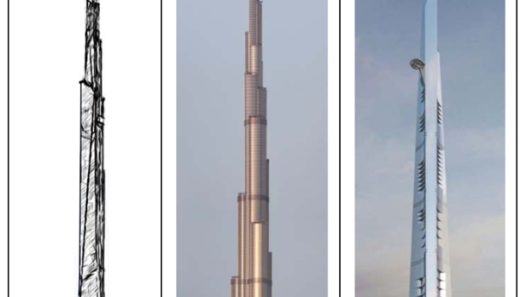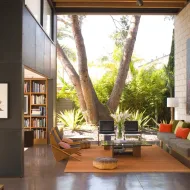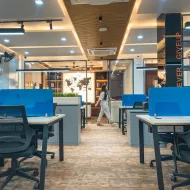Ski resort architecture is a fascinating blend of functionality and aesthetics, designed to meet the unique demands of a winter wonderland. This chapter examines the defining characteristics, historical context, key elements and global trends that shape the architectural landscape of ski resorts.

Defining Ski Centre Architecture: Concepts and Characteristics
Ski resort architecture is a distinctive style that prioritises functionality, comfort and a seamless integration with the surrounding natural environment.
- Functionality: Ski resort architecture emphasises functionality, with buildings designed to withstand harsh weather conditions, provide shelter and amenities for skiers and snowboarders, and facilitate easy access to slopes and trails.
- Aesthetics: While functionality is paramount, ski resort architecture also incorporates aesthetic elements that enhance the overall experience, creating warmth, comfort and a sense of connection with the natural environment.
- Integration with Nature: Ski resorts are often located in stunning natural settings and their architecture seeks to complement and enhance the surrounding landscape, minimising environmental impact and maximising the beauty of the location.
Historical Context and Architectural Evolution of Ski Resorts
Ski resorts have evolved considerably over time, their architecture reflecting changing trends in technology, design and social values.
- Early Ski Resorts: Early ski resorts were often characterised by simple wooden structures built to provide basic shelter and amenities for skiers.
- Mid-Century Modernism: In the mid-20th century, mid-century modernism emerged in ski resort architecture, focusing on clean lines, geometric forms and a harmonious integration with the natural environment.
- Contemporary Trends: Contemporary ski resort architecture reflects the diverse tastes and preferences of skiers and snowboarders, embracing a wide range of styles from minimalist and modern to rustic and traditional.
Basic Elements of Ski Centre Design: Functionality and Aesthetics
Ski resort architecture incorporates a number of key elements that contribute to its functionality and aesthetics:
- Slope Access: Ski resorts are designed to provide easy access to slopes and trails, with lifts, gondolas and other transport systems connecting different areas of the resort.
- Accommodation: Accommodation options in ski resorts range from cosy chalets and cabins to luxury hotels and apartments, offering a variety of facilities and accommodation to suit different needs and budgets.
- Dining and Entertainment: Ski resorts offer a range of dining and entertainment options, from casual restaurants and bars to upscale dining experiences and nightlife venues.
- Retail Sales and Services: Ski resorts offer a range of retail sales and services, including ski rental, equipment repair and other amenities that enhance the overall experience.
Relationship between Ski Resorts and their Natural Environment
Ski resorts are inextricably linked to their natural surroundings and their architecture should be designed to minimise environmental impact and enhance the beauty of the surrounding landscape.
- Sustainable Design: Sustainable design principles are increasingly being incorporated into ski resort architecture, with a focus on energy efficiency, water conservation and the use of environmentally friendly materials.
- Protection of Natural Features: Ski resorts are often located in sensitive ecosystems and their architecture should be designed to protect natural features such as forests, wetlands and wildlife habitats.
- Integration with the Landscape: Ski resort architecture seeks to blend seamlessly with the surrounding landscape, minimising visual impact and maximising the beauty of the location.
Global Trends in Ski Resort Architecture
Ski resort architecture is evolving globally to reflect changing trends in design, technology and sustainability.
- Modern and Minimalist: Modern and minimalist styles are becoming increasingly popular in ski resort architecture, with a focus on clean lines, geometric forms and the restrained use of ornamentation.
- Rustic and Traditional: Rustic and traditional styles remain popular in ski resort architecture, evoking a sense of warmth, comfort and connection to the natural environment.
- Sustainable Design: Sustainable design principles are becoming increasingly important in ski resort architecture, with a focus on energy efficiency, water conservation and the use of environmentally friendly materials.
The future of ski resort architecture is likely to be shaped by a continued focus on functionality, aesthetics and sustainability as designers strive to create spaces that enhance the ski and snowboard experience while respecting the natural environment.
Architectural Characteristics of Ski Resorts
The unique challenges and demands of a ski resort environment have shaped a distinct architectural vocabulary characterised by a mix of functionality, aesthetics and sensitivity to the surrounding landscape. This section examines the key architectural features that define ski resort design, from site planning and materials to design aesthetics and spatial organisation.
Site Planning: Integration of Buildings with Landscape
Site planning is crucial for ski resorts; it ensures that buildings are strategically located to maximise access to the slopes, minimise environmental impact and enhance the overall experience.
- Slope Access: Buildings are often positioned to provide easy access to slopes and trails; lifts, gondolas and other transport systems connect different areas of the resort.
- Views and Orientation: Buildings are carefully oriented to maximise views of the surrounding mountains and take advantage of natural sunlight.
- Environmental Sensitivity: Impact on the natural environment is considered in site planning and disturbance to forests, wetlands and wildlife habitats is minimised.
Materials and Construction: Adapting to Extreme Weather Conditions
Ski resorts face harsh weather conditions that require the use of durable and weather-resistant materials and construction techniques.
- Wood: Offering warmth, insulation and a natural aesthetic, wood is a popular material for ski resort buildings.
- Stone: Stone is often used for foundations, exterior walls and accents, providing durability and a sense of permanence.
- Metal: Metal is used for roofing, cladding and structural elements and offers strength, durability and weather resistance.
- Insulation: Buildings are well insulated to protect against cold weather and snow accumulation.
Design Aesthetics: Blending Modernity with Traditional Alpine Styles
Ski resort architecture often blends modern design elements with traditional Alpine styles, creating a unique aesthetic that reflects both functionality and connection to the surrounding landscape.
- Modernism: Modern ski resort architecture often features clean lines, geometric forms and a minimalist aesthetic, emphasising functionality and integration with the natural environment.
- Alpine Style: Traditional Alpine architecture is characterised by steep roofs, exposed wooden beams and stone accents, and evokes a feeling of warmth, comfort and connection to the mountains.
- Regional Variations: Ski resort architecture varies in different regions, reflecting local building traditions and materials.
Spatial Organisation: Balancing Public and Private Spaces
The ski resort architecture strikes a careful balance between public and private spaces, creating a warm and comfortable environment for guests while also providing opportunities for relaxation and privacy.
- Public Spaces: Public spaces such as lobbies, restaurants and bars are designed to be inviting and welcoming, encouraging a sense of community and social interaction.
- Private Spaces:Private spaces such as guest rooms, suites and apartments are designed to provide comfort, privacy and a sense of seclusion.
- Transitional Spaces: Transitional spaces such as corridors, hallways and balconies connect public and private spaces, creating a sense of flow and movement.
Important Ski Centres and Architectural Features
Ski resorts around the world exhibit a wide variety of architectural styles and features, reflecting the unique characteristics of their locations and the vision of their designers.
- Whistler Blackcomb (Canada): This world-famous ski resort features a mix of modern and traditional architecture with a focus on sustainability and integration with the natural environment.
- Zermatt (Switzerland): This charming village resort is known for its traditional Alpine architecture, with wooden chalets and stone buildings that blend seamlessly into the surrounding mountains.
- Aspen (Colorado): This luxury ski resort features a mix of modern and traditional architecture with a focus on luxury and exclusivity.
The architectural features of ski resorts are a testament to the ingenuity and creativity of designers who adapt to the unique challenges and demands of a winter wonderland. From site planning and materials to design aesthetics and spatial organisation, ski resort architecture reflects a commitment to functionality, aesthetics and a harmonious relationship with the natural environment.
The Role of Sustainability in Ski Resort Design
As the world grapples with the urgent need for environmental responsibility, the ski industry is increasingly adopting sustainable practices. This chapter explores the important role of sustainability in ski resort design, highlighting eco-friendly practices, energy efficiency, water management, community engagement and inspiring case studies.
Environmentally Friendly Applications: Sustainable Materials and Construction Techniques
Ski resorts adopt sustainable materials and construction techniques to minimise their environmental footprint.
- Locally Sourced Materials: Using locally sourced materials reduces transport costs and emissions, supporting local economies and minimising environmental impact.
- Recycled and Renewable Materials: Using recycled and renewable materials such as reclaimed wood, recycled steel and bamboo reduces reliance on virgin resources and promotes circularity.
- Passive Design: Passive design principles such as maximising natural light, utilising solar heat gain and incorporating ventilation strategies reduce energy consumption and dependence on artificial heating and cooling systems.
Energy Efficiency: Innovations in Heating and Insulation
Ski resorts are implementing innovative solutions to improve energy efficiency and reduce dependence on fossil fuels.
- Renewable Energy Sources: The use of renewable energy sources such as solar panels, wind turbines and geothermal energy reduces dependence on fossil fuels and minimises greenhouse gas emissions.
- High Performance Insulation: The application of high performance insulation in buildings reduces heat loss and minimises dependence on heating systems by increasing energy efficiency.
- Energy Efficient Devices: Using energy efficient devices such as LED lighting, high efficiency boilers and smart thermostats reduces energy consumption and lowers operating costs.
Water Management: Addressing Snow Making and Resource Utilisation
Snowmaking is a crucial aspect of ski resort operations, but it also requires significant water resources. Sustainable ski resorts are implementing water-saving practices.
- Water Conservation: Using water-efficient snowmaking systems such as low-energy snow guns and water recycling systems minimises water consumption and reduces environmental impact.
- Rainwater Harvesting: Harvesting rainwater for snowmaking and other uses reduces reliance on potable water supplies and conserves valuable resources.
- Water Efficient Landscaping: Implementing drought-tolerant landscaping and water efficient irrigation systems reduces water consumption and promotes biodiversity.
Community Engagement: Involving Local Stakeholders in Design Processes
Sustainable ski resort design goes beyond technical solutions and requires collaboration and engagement with local communities.
- Community Engagement: Involving local stakeholders in the design process ensures that projects are aligned with community values and priorities, fostering a sense of ownership and support.
- Cultural Sensitivity: Respect for local traditions, values and cultural heritage ensures that development projects are sensitive to the unique character of the region.
- Economic Benefits: Sustainable development practices can create economic opportunities for local communities, support businesses and create jobs.
Exemplary Practices: Sustainable Ski Resorts Leading the Way
Many ski resorts around the world are leading the way in sustainable design and operations.
- Zermatt (Switzerland): This iconic ski resort has implemented a comprehensive sustainability programme, including a commitment to renewable energy sources, water conservation measures and waste reduction.
- Whistler Blackcomb (Canada): This world-renowned ski resort has achieved LEED certification for its buildings and has implemented a range of sustainable practices, including energy efficiency, water conservation and waste reduction.
- Aspen (Colorado): This luxury ski resort has committed to reducing its environmental impact through initiatives such as renewable energy, sustainable transport and waste reduction.
These case studies demonstrate that sustainable design principles can be successfully applied to ski resorts, creating a more environmentally responsible and economically viable future for the industry.
Social and Economic Impact of Ski Resorts
Ski resorts are not just winter playgrounds; they are complex economic engines that promote tourism, create jobs and shape the social fabric of the communities around them. This chapter explores the multifaceted social and economic impacts of ski resorts, examining their role in tourism development, social cohesion, employment opportunities, infrastructure development and regional growth.
Tourism Development: Economic Benefits of Ski Resorts
Ski resorts are a major driver of tourism, attracting visitors from around the world and generating significant economic activity.
- Visitor Expenditure: Tourists visiting ski resorts contribute to the local economy by spending money on accommodation, food, entertainment, ski hire and other services.
- Seasonal Employment: Ski resorts generate income for local people by creating seasonal employment opportunities in accommodation, retail, transport and other sectors.
- Tax Revenue: Ski resorts generate tax revenue for local governments, which can be used to fund public services and infrastructure projects.
Community Cohesion: The Role of Ski Resorts in Local Economies
Ski resorts can play a vital role in promoting community cohesion by providing opportunities for social interaction, recreation and economic development.
- Shared Experiences: Ski resorts promote a sense of community and shared identity by creating shared experiences for residents and visitors.
- Economic Opportunities: Ski resorts provide economic opportunities for local businesses, supporting local entrepreneurs and creating jobs for residents.
- Community Events: Ski resorts often host community events such as festivals, concerts and sports competitions, bringing people together and fostering a sense of belonging.
Employment Opportunities: Job Creation in Holiday Zones
Ski resorts contribute to the economic well-being of surrounding communities by creating a wide range of employment opportunities, both seasonal and year-round.
- Hospitality and Tourism: Ski resorts employ staff in hotels, restaurants, bars, retail shops and other hospitality and tourism related businesses.
- Ski Operations: Ski resorts employ staff to operate lifts, maintain pistes, maintain equipment and provide ski instruction.
- Construction and Maintenance: Ski resorts support the development and maintenance of facilities by creating jobs in construction, maintenance and landscaping.
Infrastructure Development: Impacts on Transport and Services
Ski resorts often encourage infrastructure development, improve transport networks, expand public services and enhance the quality of life in surrounding communities.
- Transport Infrastructure: Ski resorts often invest in transport infrastructure such as roads, motorways and public transport systems to improve access for visitors and residents.
- Public Services: Ski resorts can benefit both residents and visitors by contributing to the expansion of public services such as schools, hospitals and libraries.
- Community Facilities: Ski resorts often improve the quality of life of residents by providing community amenities such as parks, recreation centres and cultural facilities.
Ski Centres Contributing to Regional Development
Ski resorts can play an important role in regional development, attracting investment, creating jobs and boosting economic activity in surrounding areas.
- Economic Diversification: Ski resorts can help diversify regional economies, reducing dependence on a single sector and creating a more resilient economic base.
- Tourism Promotion: Ski resorts can promote tourism in surrounding areas, attracting visitors to explore local attractions, experience regional culture and support local businesses.
- Infrastructure Improvements: The development of ski resorts can stimulate infrastructure improvements in the surrounding areas, benefiting both residents and businesses.
The social and economic impacts of ski resorts are multifaceted and include tourism development, community cohesion, employment opportunities, infrastructure development and regional growth. While ski resorts can provide significant economic benefits, it is important to consider their potential social and environmental impacts and ensure that development is sustainable and benefits both local communities and the environment.
Cultural Significance of Ski Resort Architecture
Beyond its functional aspects, ski resort architecture has a unique cultural significance, reflecting the traditions, values and aspirations of the communities it serves. This chapter explores the cultural impact of ski resort design and examines its role in preserving heritage, promoting community, integrating local arts and balancing development with environmental protection.
Identity and Heritage: Architectural Expressions of Alpine Culture
Ski resort architecture often serves as a tangible expression of local culture and heritage, preserving traditional building styles and materials that have evolved over generations.
- Alpine Style: Characterised by steep roofs, exposed wooden beams and stone accents, traditional Alpine architecture evokes a sense of warmth, comfort and connection to the mountains.
- Regional Variations: Ski resort architecture varies in different regions, reflecting local building traditions, materials and cultural influences.
- Heritage Preservation: By incorporating traditional architectural elements, ski resorts can help preserve local heritage and ensure that future generations can appreciate the unique character of their community.
Public Spaces: Creating Community Spaces within Ski Resorts
Ski resorts often create public spaces that serve as gathering places for residents and visitors, encouraging a sense of community and social interaction.
- Village Squares: Ski resort villages often have central squares or plazas where people can gather, socialise and enjoy local events.
- Restaurants and Bars: Restaurants and bars in ski resorts provide opportunities to socialise, eat and enjoy live music or entertainment.
- Community Centres: Some ski resorts offer community centres or recreation facilities that provide opportunities for residents to participate in activities and events.
Art and Design: Integrating Local Craft into Resort Architecture
Ski resort architecture can showcase local art and craftsmanship by integrating traditional techniques and materials into modern design.
- Handmade furniture: Ski resort interiors often feature handmade furniture, textiles and artworks that showcase the skills of local artisans.
- Local Materials: The combination of locally sourced materials such as wood, stone and metal gives ski resort architecture a unique character and supports local economies.
- Art Installations: By incorporating art installations and sculptures into their design, ski resorts can enhance the aesthetic appeal of the environment and showcase the creativity of local artists.
Conservation of Natural Landscapes: Balancing Development and Conservation
Ski resort architecture plays a crucial role in balancing development with the protection of the natural landscape, ensuring that the beauty and integrity of the environment is preserved.
- Sustainable Design:Sustainable design principles such as energy efficiency, water conservation and the use of environmentally friendly materials minimise the environmental impact of ski resort development.
- Integration with Nature: Ski resort architecture often seeks to blend seamlessly with the surrounding landscape, minimising visual impact and maximising the beauty of the location.
- Conservation Efforts: Ski resorts can support conservation efforts by protecting natural habitats, reducing pollution and promoting sustainable tourism practices.
The cultural significance of ski resort architecture goes beyond its aesthetic appeal, reflecting the values, traditions and aspirations of the communities it serves. By adopting sustainable design principles, integrating local art and fostering a sense of community, ski resort architecture can contribute to preserving cultural heritage, enhancing the natural environment and creating vibrant and welcoming spaces for all.





















